


|
| ||
|
|
|
|

|
SILVER EDITION

|


|
SILVER EDITION |
The Vallejo Reprints
by Simon van Meygaarden
At the end of 1973, only eight years after his initial take-off, John Norman was without a publisher.
[UPDATE] Despite the refusal of any further instalments, Ballantine retained the rights of the first seven Gor novels, and continued to publish reprints of these books. In January 1973, the first Canadian printings of Priest-Kings of Gor, Nomads of Gor, Assassin of Gor and Captive of Gor were published, together with second Canadian printing of Tarnsman of Gor, Outlaw of Gor and Raiders of Gor. By the end of 1973, Tarnsman of Gor, Outlaw of Gor and Priest-Kings of Gor had seen a sixth printing; Nomads of Gor and Assassin of Gor a fifth printing, and Raiders of Gor and Captive of Gor a third printing; all using the cover layout of the Black Text Edition shown earlier.
Meanwhile, in the United Kingdom, the Sidgwick & Jackson Edition had ended, and starting in 1970, publishing house Tandem, London, had taken over the publication of the Gor novels. By the end of 1973, the first six Gor volumes were available in a Tandem Edition. In Germany, negotiations about a German translation had finally succeeded, and in 1973, "Gor Die Gegen-Erde" was released by Wilhelm Heyne, Munchen.
 Ballantine Red Title Series
Ballantine Red Title Series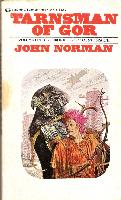
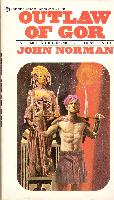
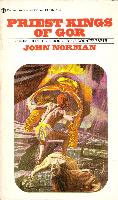
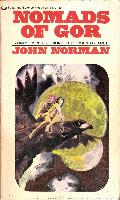
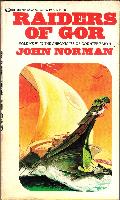
During the second half of the '60s, Ballantine Books had employed a fellow named Ian Summers as their art director. Summers was highly personable and hugely talented, after discovering the Hildebrandts, and giving Darrell Sweet his first assignments in the genre, he was smart enough to use Murray Tinkelman to repackage the company's Lovecraft line, knowing that Tinkelman's fine-line Rapid-o-graph work would lighten the look of the covers while still retaining the horror identity and would simply stand off the racks because it was so different from everything else around it. Ian Ballantine's personal problems finally precipitated his departure from Ballantine in the late 1974s, but for a few years, at least, the genre finally got the quality of art and the level of respect it deserved.
In 1974, Ian and Betty Ballantine left Ballantine Books, and Judy-Lynn del Rey started an economic boom and a resurgence of classic works and new adult fantasy. In 1975, part of the series was again restyled and reprinted.
 Ballantine Stone Cover Series
Ballantine Stone Cover Series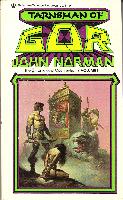
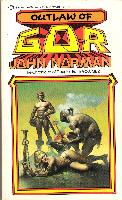
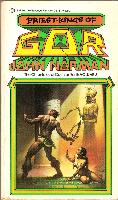
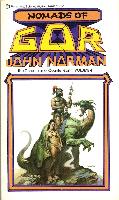
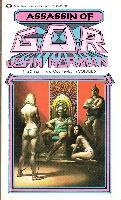
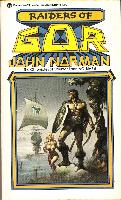
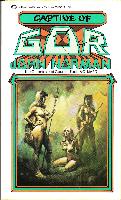
During the summer of 1976, Judy-Lynn's husband, Lester del Rey, a well-known author in the field, joined the editorial staff to oversee the fantasy line, and Don Smith took over the work of Ian Summers. Smith hated the work of just about everyone Summers had used and dropped them all except Darrell Sweet. Cover art returned to the narrative look, now reduced virtually to formula, and in addition to the growth of editorial control over covers, the marketing people began to intrude into the process.
Strangely enough, while the series itself seemed much to provocative for Ballantine to continue publication, the reprints of the first seven novels were dramatically enhanced by stunning new artwork by the hand of Boris Vallejo. The artwork of Vallejo showed crystal-clear images from the story line, and for the first time in science fiction, sexy content was merged with sexy covers.
So why did Ballantine refuse Hunters of Gor?
In an extensive interview with John Norman, published in 1996 by the New York Review of Science Fiction, David Alexander Smith made the following analysis.
Over the course of the novels, the themes seem to change. The early novels are action-oriented male fantasies. Tarl Cabot is strong, fierce, capable, self-contained, brave, just, and shrewd. A civilized man in a barbarian world, he is uniquely capable of mixing justice and equity with iron discipline, and as such he rises rapidly in Gor's meritocracy of the sword. Though Cabot is perfectly capable of meeting the Gorean world's savagery with his own, he generally succeeds because of his kindness toward women (Tarnsman) or his equity toward prisoners (Outlaw) or naval slaves (Raiders). While the world in these early books is savage, also are its priest-kings, people, and creatures, your Earthman protagonist is not - and that is the foundation of his success. In these stories women have at best a peripheral role; the novels concern Cabot's external struggles, and his internal battles against his own guilt and sense of lost honor. By the later novels, the themes are almost exclusively the sexual and social relations of men and women, with recurring and comprehensive demonstrations that, at least on Gor, men and women find their spiritual and sexual fulfillment in different ways.
In between the Ballantine and the DAW books is Hunters of Gor, the hinge book. I find it remarkable. At first it seems much in the line of its predecessors-after all, it is narrated by Tarl Cabot, and the novel's outward action involves his quest to find and free Marlenus, Ubar of Ar. Actually, the novel is principally concerned with the constant skirmishes between Cabot and Marlenus's raiding parties and the misandronous panther girls. After many encounters, most of which involve the victor staking out the vanquished naked on the ground, the men eventually conquer the women, whereupon a remarkable transformation occurs. All of the panther girls, except their leader, fling themselves joyfully upon their conquering men, ecstatic at becoming sexual and social slaves, delighted that in overcoming their pose of independence, their captors have genuinely freed them from themselves. This plot line is qualitatively different from the previous stories, where slavery and sexuality are present but the main story is adventure.
Though in Hunters both men and women are enslaved, slavery's depiction, and their reactions to it, differ greatly between the sexes. Cabot is made a slave. He resists violently and it is clear that to keep him a slave would be so humiliating that he would rather die. Being a slave thwarts essential elements in Cabot's character. The women, on the other hand, fight slavery but come to understand that it is their highest state. I cannot remember if anyone in Hunters says "Kiss the whip," but the sentiment, which is echoed frequently in the later novels, aptly expresses the breakthrough moment for the women you depict. Doesn't that express violence against women?
John Norman: The issue is not violence but dominance and strength. Many women respond to strength and force. They like it. They want it. Most women want a man capable of mastering them.
 Ballantine 1st Del Ray Stone Cover Series
Ballantine 1st Del Ray Stone Cover Series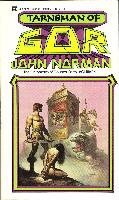
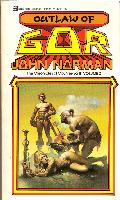
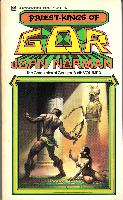
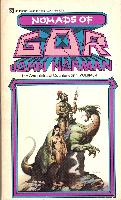
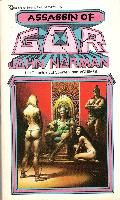
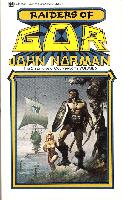

In 1977, Judy-Lynn became editor-in-chief of DEL REY Books and the Del Rey imprint was formed. Using the same artwork as the previous Ballantine Stone Cover series, the first seven Gor books were again reprinted as Del Rey Stone Covers. Note the color change of Nomads of Gor.
In Imaginative Sex, published in 1974 by Donald Wollheim's DAW Books, John Norman explicitly stated that:
Is Gor the expression of a philosophy of sexual fantasy?
John Norman: Fantasy in sexuality allows for a deepening and broadening of sexual relationships and an incredible enrichment of the sexual existence. A sexual life with the imagination left out seems to me to be a sexual life certainly beneath the potential of a rational animal. If imagination is permissible and commendable in life - which is, of course, the essential premise of science fiction and fantasy - then it seems obvious that it should also be permissible and commendable in one's sexual life.
 Ballantine 2nd Del Ray Stone Cover Series
Ballantine 2nd Del Ray Stone Cover Series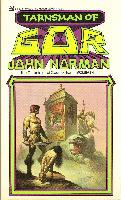
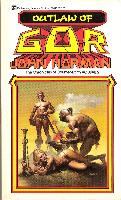
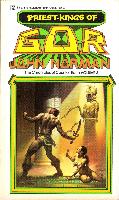
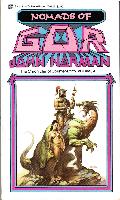
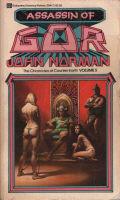
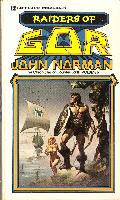
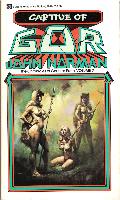
In 1980 the series was again restyled, using the same basic cover design as the previous Stone Cover editions, yet with an inversed coloring of the title.
During that same year, John Norman responded to the charge that his books exploit sex and violence - that they debase and debauch the human spirit, within the Questar Interview by Jeffrey M. Elliot.
John Norman: There seem to me two very different charges here. Let us consider them separately.
First, the word 'exploit' is, of course, a hostile word, a signal word, chosen, I assume deliberately, to prejudice a reader. It is not the sort of expression an objective individual would choose. On the other hand, let us not quibble about semantics. Certainly, sex and violence occur in the Gorean novels; certainly, sex and violence are used in the Gorean novels. They are significant plot elements. Perhaps to the horror of the critic, I see no reason to be apologetic about this. I guess I am just less guilty or timid, or something, than he is. Though the critic will not understand this, judging by the intellectual or emotional level suggested in the criticism, sex and violence are both real parts of life. History and human reality would be inexplicable without them. They belong in any strong, honest literature. To advocate writing an emotionally truncated, expurgated, namby-panby literature is, I suppose, permissible, but, it seems to me, it is certainly not desirable. Indeed, from my point of view, such a refusal to write honestly constitutes a betrayal of literature which I find not only aesthetically offensive but unreasonable and, I think, morally improper. The question here is a simple one: Is the writer to be honest to life, in its fullness, or not? I would think so, but that is my own answer. I cannot answer for others. Let those who fear to think and feel write without emotion or thought. Let those who can both feel and think write with both emotion and thought. Incidentally, while we are on the topic, it might also be noted, in fairness, that the Gorean books exploit discipline, courage, nobility, honor, and love. The human being, with his heights and glories, his depths and cruelties, exceeds in complexity and reality the abstractions and ideal izations of the frightened and the weak. It will always be thus. I love man and fear him; thus I will celebrate him. I will try to honor him as being as he is; not as fools might wish him.
The second charge has something to do with 'debauching' and 'debasing' the 'human spirit.' It is difficult to know how to respond to a criticism of this sort, because it is difficult to know if the critic intends it to be understood literally or figuratively. If the critic intends it to be taken literally, it seems to be obviously false. There is no such thing, literally, as far as I can tell, as 'the human spirit.' Accordingly, it can neither be debased nor debauched. Similarly, there is no such thing, strictly, as far as I can tell, as a 'giraffe spirit' or the 'spirit of apple pie.' On the other hand, on the assumption that the critic is at least vaguely aware of developments in science in the past 120 years, specifically in the sciences of biology, psychology and anthropology, we may assume that he intended it figuratively. But if this is so, it might mean a number of different things. Accordingly, he could always claim that whichever possibility I chose to discuss was not that which he intended. On the other hand, since that cannot be helped and is a predictable response, I think I have little choice but to steam ahead. Accordingly, I shall do so. The 'human spirit,' I am afraid, for better or for worse, is more complicated than our critic understands. All things that human beings do are manifestations of the 'human spirit.' If the critic would understand the nature of the 'human spirit,' I suggest to him that he consult the tapestries and pageants of history. In those bloody threads he will find its biography delineated. There he will discover that hunting, and pride, and lust, and victory are as much authentic manifestations of the 'human spirit' as the planting of flowers and the dreams of innocence. Indeed, they seem more germane to its iron and its songs than hypocrisy and lace. One of the strengths of the Gorean books, in my opinion, is that they constitute one of the few places in contemporary literature where the 'human spirit,' as it exists in reality, and not in the abstractions of political mythologies, is neither denied nor distorted. The Gorean books celebrate the 'human spirit' in its fullness, in its darkness and its glory, in its pettiness and cruelty, in its shame and in its incomparable splendors.
 Ballantine 3rd Del Ray Stone Cover Series
Ballantine 3rd Del Ray Stone Cover Series
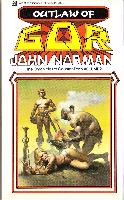
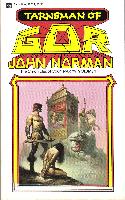
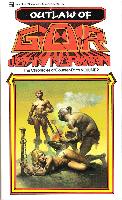
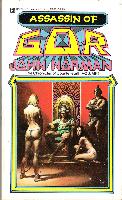
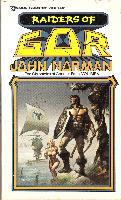

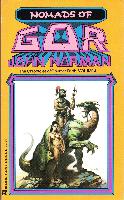
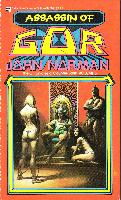
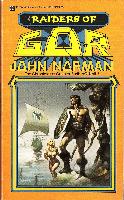
By the end of the '80s, Ballantine released several special sets of Gor books, including these 3rd and 4th Del Ray Stone Covers, and the Orange Covers.
 Conclusion
ConclusionThe first seven Gor books were published by Ballantine Books between December, 1966 and December, 1972, and they were reprinted until the twenty-third reprint of Tarnsman of Gor in July, 1990, the twenty-second reprint of Outlaw of Gor in November, 1989, the eightteenth reprint of Priest-Kings of Gor in May, 1988, the eightteenth reprint of Nomads of Gor in December, 1987, the twenty-first reprint of Assassin of Gor in February, 1991, the sixteenth reprint of Raiders of Gor in July, 1985 and the twentiest reprint of Captive of Gor in February, 1991. Based upon 10,000 copies for each reprint, the total number of printed books seems to be about 1,400,000 copies.
Was John Norman surprised by the tremendous controversy that has grown up around his work? Why does he think it exists?
John Norman: Yes, I am surprised. I'm not sure why there is so much controversy.
The books seem to be pretty innocent. After all, what is so terrible about taking ethnology, or depth psychology seriously? I think the reasons for the controversy are irrational, rather than rational. Apparently, some people read the Gorean books with the dispassionate objectivity of a psychotic interpreting Rorschach blots. They see anything they wish to see in them. As a result of these projections, they are apparently sometimes disturbed. One has trouble, for example, with the sexual hysterics. Some of these have perhaps found a refuge in science fiction, which, commonly, even today, tends to avoid coming to grips with the nature and problems of human sexuality. There are, however, doubtless many other reasons for controversy as well. Three other factors come immediately to mind.
First, the resentment of certain in-group individuals to the success of a newcomer; this resentment can be rationalized, of course, in a variety of ways; one hates first, then one thinks up reasons. Secondly, the Gorean books present a different ethos and take it seriously. This frightens some people because it makes them feel insecure; everyone is supposed to have the right opinions and values - theirs. When they meet someone who presents a genuinely alternative conceptualization of reality, an intellectual alternative rather than a merely mechanical alternative, they become alarmed; they feel threatened. They are only verbally in favor of diversity of thought; their rhetoric of freedom is revealed as hypocrisy; it is belied by their bigotry and intolerance.
Thirdly, the Gorean books have introduced new subject matter and new ideas to science fiction. They have plowed new conceptual furrows; they have altered, in the thinking of thousands, the conceptions and horizons of science fiction. The borders of science fiction have been extended by my work; new possibilities have been delineated and explored. It is natural that these changes would be felt as threatening to a vain, stale, insecure establishment. Will the old formulas no longer work? Will their own work seem unimaginative and juvenile by contrast? Will they suffer a loss in prestige? Are the Huns truly at the gate? If I knew how, I would like to reassure these frightened people. They have their strengths and weaknesses, as I do; they have their naiveties, their stupidities, their frailties, as I do. Perhaps the Hun at the gates is not really so different from themselves as they might fear. Perhaps he, too, has a respect and affection for a genre. Science fiction is a big place, really. It contains many countries. It is robust, it is healthy. Let them live and write. Let us each, in our ways, attempt to dignify our art and celebrate the wonders of the worlds of the imagination. The universe is large; I think there is room for all of us out there.
TO BE CONTINUED
 Afterword
AfterwordThe first version of this article was written in January, 2001, and first published on March 1st, 2002, as Feature Article, by The Gorean Voice. It was slightly edited and enhanced in 2009, scheduled to be published at the Chronicles of Gor, in July, 2010. We never got around to it, and in September, 2012, due to internal problems, the publication was cancelled.
For this enhanced version, I improved the layout, added a table of contents, added new cover images, turned them into links, updated much of the bibliographical data, and added this afterword.
"The Start of the Series" was written by Simon van Meygaarden,
and first published in The Gorean Voice - March 2002 - Vol IV Issue 9 - #45 ,
under copyright ® 2002 by The Gorean Group, Inc.
This enhanced and updated version was created in August, 2012.
Copyright ® 2002/2012 by Simon van Meygaarden. All Rights Reserved.
 This page is copyright © 2000/2013 by Simon van Meygaarden & Jon Ard - All Rights Reserved
This page is copyright © 2000/2013 by Simon van Meygaarden & Jon Ard - All Rights Reserved